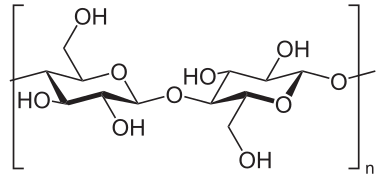Cellulose

Cellulose is a non-starch polysaccharide carbohydrate (actually a type of beta-glucan), and it is located primarily in the barley husk and embryo. Structurally, cellulose is a polymer of glucose bound together by (1,4)-β-glycosyl linkages.[1]
Cellulose is indigestible to humans and also very resistant to degradation by enzymes. It does not dissolve in the wort during mashing, and therefore it is discarded with the spent grains. Its main importance is to act as a filter material during lautering.[2][3]
Cellulose is degraded to a very limited extent by a cellulase enzyme, also known as (1,4)-β-glucanase.[1] Microbes on the grain appear to be responsible for contributing this enzyme during the malting process, and therefore its level of activity is unpredictable.
References[edit]
- ↑ a b Evans E. Mashing. American Society of Brewing Chemists and Master Brewers Association of the Americas; 2021.
- ↑ Kunze W, Hendel O, ed. Technology Brewing & Malting. 6th ed. VLB Berlin; 2019:47.
- ↑ Briggs DE, Boulton CA, Brookes PA, Stevens R. Brewing Science and Practice. Woodhead Publishing Limited and CRC Press LLC; 2004.
